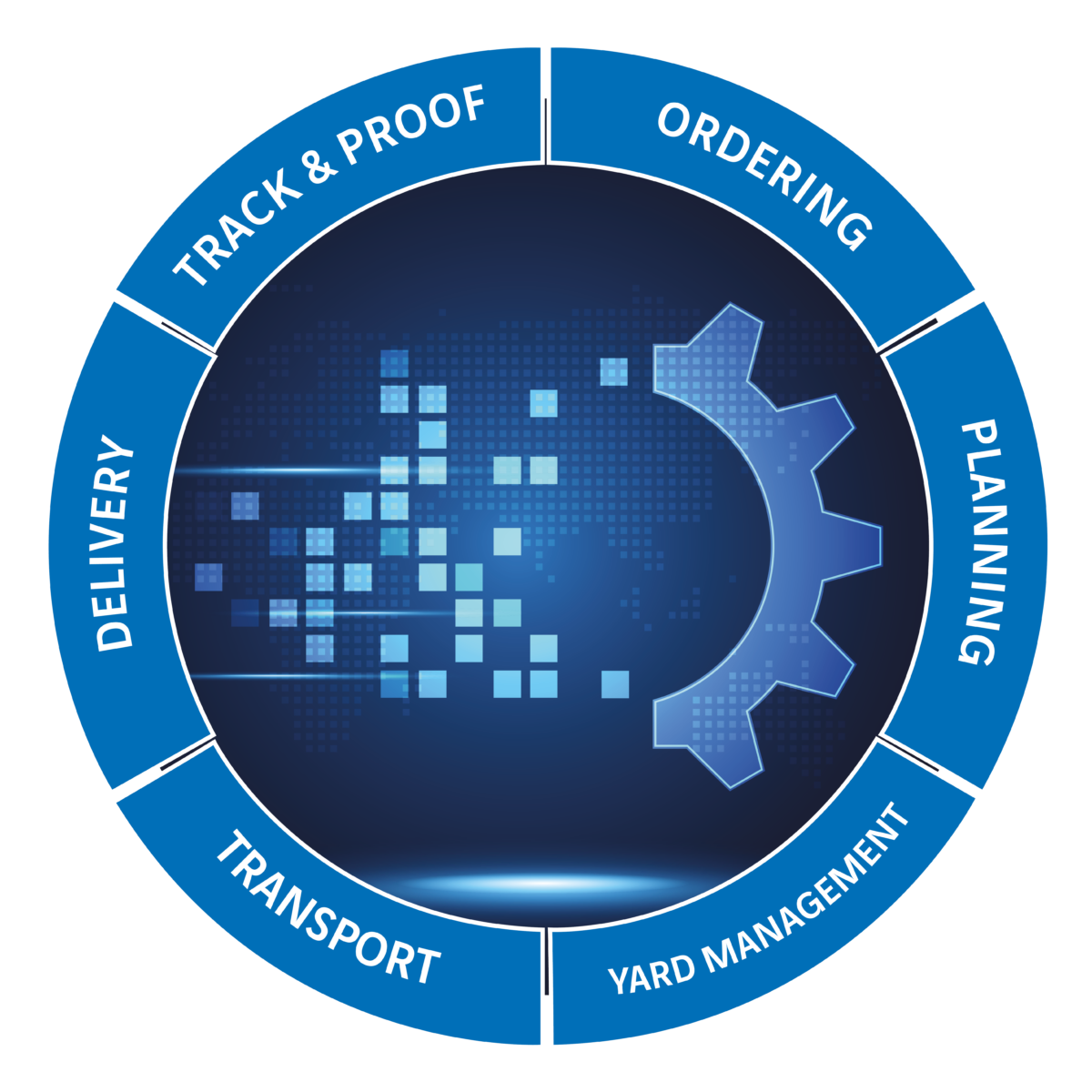When it comes to process automation, the focus for many building materials suppliers today is on shipping processes in the plant, i.e. yard management.
But the entire logistics workflow for construction materials such as sand, gravel, cement and concrete, as well as for landfill material, starts much earlier, before a truck enters the plant, and involves many different roles and players in addition to the material supplier. A flexible ordering process, extensive planning functionalities and full transparency and data consistency for all parties involved are just some of the requirements for a central, cross-plant logistics workflow.
What is meant by a central logistics workflow in the building materials industry?
What requirements must the central logistics workflow meet?
In addition to the requirement to offer a solution that covers a wide spectrum, simple, role-oriented operability and extensive and flexible integration options with other software solutions are essential for a central logistics workflow. This makes it possible to avoid today’s widespread isolated solutions with the massive disadvantage of inconsistent data in different areas and a lack of transparency. Data is captured once and automatically reused for different use cases. The error-prone, manual multiple entry of data is eliminated and processes become faster and more secure.
In summary, these requirements can be divided into three areas:
To minimize the administration effort for the user and to ensure flexible access at various locations, a cloud-based solution such as VAS Cloud Logistics is ideal for the central logistics workflow.
Who uses the central logistics workflow?
It is important to provide targeted support for the various roles through a workflow solution, as briefly described here from the perspective of a building materials producer:
- The customer who orders material
- The order taker at the supplier
- The order planner / dispatcher at the supplier
- The transport planner / dispatcher at the forwarder
- The driver who loads the material at the plant and transports it to the recipient
- The weigher or administrative employee in the plant
- The recipient of the material (e.g. construction site or mixing plant)
This overview already clearly shows the high demands on a modular and role-oriented solution
From customer ordering, order and transport planning, shipping and delivery: Tailored portals and apps should be available for different workflow roles, so that from the orderer / customer, to the material supplier’s dispatcher, to the forwarder, the driver, weigher, administration and the building material recipient or construction site, all roles involved have their individual views and required functions.
What processes are there in the central logistics workflow?
The processes in the central logistics workflow should be seamlessly integrated with each other to enable consistent and error-free processing and documentation:
Often, only manual input channels such as telephone or mails are available for this task, which limits order entry to the supplier’s working hours. In most cases, consistent feedback to the purchaser is also lacking.
An online ordering platform (customer portal) offers 24/7 availability here and reduces errors in the ordering process. The flexibility of the buyer is not restricted, as the order taker can still enter manually received orders into the online tool if required. This also creates a reliable database for downstream scheduling.
Orders or call-offs from the customer must be checked, scheduled and assigned to a transport company or the company’s own fleet. In addition, the terms of blanket orders with customers must be observed
Shortest reaction times and frequent changes by customers or forwarders characterize the daily business of a dispatcher. This requires a high degree of flexibility and transparency to enable the dispatcher to optimize planning.
Deliveries are ordered by the building material supplier or its customers from forwarding agents or an internal fleet of vehicles. What is required here is the management of all transport orders, the allocation and scheduling of specific vehicles, and close, preferably automated, communication between all the roles involved. These processes are often still handled completely manually or via Excel planning and e-mail or WhatsApp communication and therefore offer a high potential for optimization.
The classic, manually created and paper-based delivery bill is usually created directly at loading or at the plant exit. High manual and error-prone efforts, lack of transparency and intensive use of resources (paper, toner, etc.) show the need for more modern solutions. Automated electronic creation of delivery documents (locally at the plant) is ideally combined with automatic distribution of this data via a central logistics workflow to all roles that require this data (producer, customer, carrier, recipient).
This is also the perfect preparation for higher automation of the delivery process.
If the delivery data is available electronically to all relevant recipients, the basis is also created for tracking the actual delivery and making this data available to the driver (e.g., with an app on the smartphone) in a simple and paperless manner. Combined with telematics systems, this enables delivery tracking.
The actual delivery of the goods to the recipient also offers high automation potential. A manual signature by the recipient on a paper-based delivery bill provides proof of delivery, but involves manual effort, both on-site at the recipient’s location and in the redistribution of this proof of delivery to the administration of the customer, the carrier, and the building materials supplier. If delivery data is available online on a driver’s app, these steps can be automated. This includes both the electronic proof of delivery in this app and the automated forwarding of this information to all relevant recipients via a central, software-supported logistics workflow.
For which industries is a central logistics workflow relevant?
A strong, centralized automation solution is relevant for companies in all sectors of the building materials or bulk materials industry, whether cement, sand and gravel, lime, asphalt, or concrete. The requirement to handle logistics tasks more simply, more predictably and with lower costs is present in all industries and is becoming increasingly important.

For which companies is a central logistics workflow suitable?
A central logistics workflow is generally suitable for medium-sized and large companies in the bulk materials industry. Differences certainly arise due to the size of the companies, which has an influence, for example, on whether many processes are handled by a higher-level ERP system (such as SAP) with the integration of a dedicated logistics workflow solution, or whether a logistics workflow solution itself is the higher-level instance. What is needed here are modular and scalable solutions that can be adapted to the respective requirements and can be integrated into an ecosystem with open interfaces.

Do you have any questions?
Contact our experts!
Phone: +49 731 1551-0
Mail: info@axians‑ias.com


